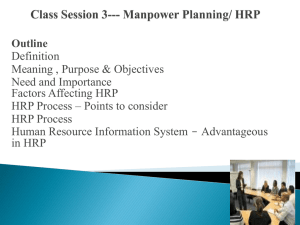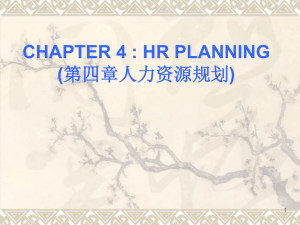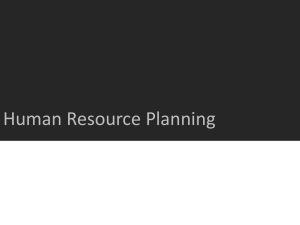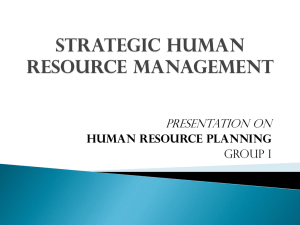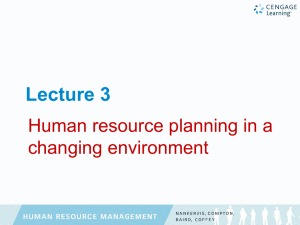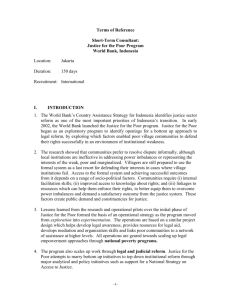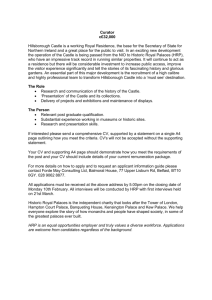Human Resource Planning - An Analytical Study
advertisement
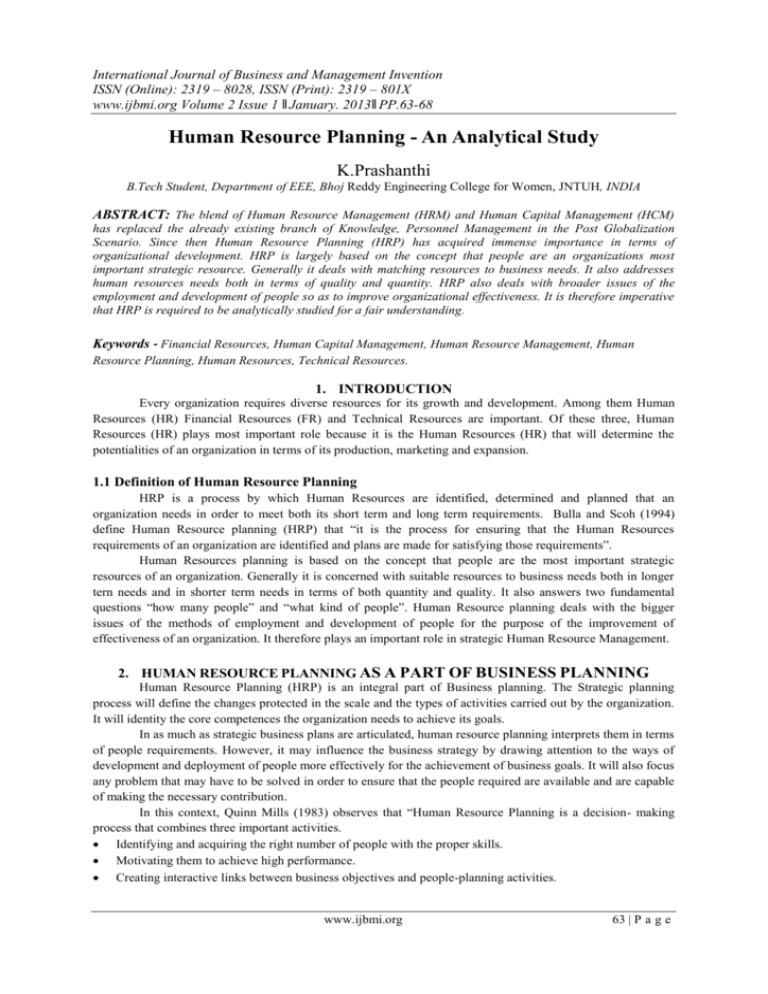
International Journal of Business and Management Invention ISSN (Online): 2319 – 8028, ISSN (Print): 2319 – 801X www.ijbmi.org Volume 2 Issue 1 ǁ January. 2013ǁ PP.63-68 Human Resource Planning - An Analytical Study K.Prashanthi B.Tech Student, Department of EEE, Bhoj Reddy Engineering College for Women, JNTUH, INDIA ABSTRACT: The blend of Human Resource Management (HRM) and Human Capital Management (HCM) has replaced the already existing branch of Knowledge, Personnel Management in the Post Globalization Scenario. Since then Human Resource Planning (HRP) has acquired immense importance in terms of organizational development. HRP is largely based on the concept that people are an organizations most important strategic resource. Generally it deals with matching resources to business needs. It also addresses human resources needs both in terms of quality and quantity. HRP also deals with broader issues of the employment and development of people so as to improve organizational effectiveness. It is therefore imperative that HRP is required to be analytically studied for a fair understanding. Keywords - Financial Resources, Human Capital Management, Human Resource Management, Human Resource Planning, Human Resources, Technical Resources. 1. INTRODUCTION Every organization requires diverse resources for its growth and development. Among them Human Resources (HR) Financial Resources (FR) and Technical Resources are important. Of these three, Human Resources (HR) plays most important role because it is the Human Resources (HR) that will determine the potentialities of an organization in terms of its production, marketing and expansion. 1.1 Definition of Human Resource Planning HRP is a process by which Human Resources are identified, determined and planned that an organization needs in order to meet both its short term and long term requirements. Bulla and Scoh (1994) define Human Resource planning (HRP) that “it is the process for ensuring that the Human Resources requirements of an organization are identified and plans are made for satisfying those requirements”. Human Resources planning is based on the concept that people are the most important strategic resources of an organization. Generally it is concerned with suitable resources to business needs both in longer tern needs and in shorter term needs in terms of both quantity and quality. It also answers two fundamental questions “how many people” and “what kind of people”. Human Resource planning deals with the bigger issues of the methods of employment and development of people for the purpose of the improvement of effectiveness of an organization. It therefore plays an important role in strategic Human Resource Management. 2. HUMAN RESOURCE PLANNING AS A PART OF BUSINESS PLANNING Human Resource Planning (HRP) is an integral part of Business planning. The Strategic planning process will define the changes protected in the scale and the types of activities carried out by the organization. It will identity the core competences the organization needs to achieve its goals. In as much as strategic business plans are articulated, human resource planning interprets them in terms of people requirements. However, it may influence the business strategy by drawing attention to the ways of development and deployment of people more effectively for the achievement of business goals. It will also focus any problem that may have to be solved in order to ensure that the people required are available and are capable of making the necessary contribution. In this context, Quinn Mills (1983) observes that “Human Resource Planning is a decision- making process that combines three important activities. Identifying and acquiring the right number of people with the proper skills. Motivating them to achieve high performance. Creating interactive links between business objectives and people-planning activities. www.ijbmi.org 63 | P a g e Human Resource Planning - An Analytical Study “In situations where a clear business strategy does not exist, human resource planning may have to rely more on making broad assumptions about the need for people in the future based on some form of Scenario Planning” (Michael Arm Strong 2008). 2.1 Types of HRP There are two types of Human Resource Planning (HRP). Hard Human Resource Planning. Soft Human Resource Planning. HRP based on quantitative analysis in order to ensure that the right number of the right sort of people are available when needed is called Hard Human Resource Planning. HRP concerned with ensuring the availability of people with the right type of attitudes and motivation and commitment to the organization is called Soft Human Resource Planning. Marchington and Wilkinson (1996) describe that “Soft Human Resource Planning is more explicitly focused on creating and shaping the culture of the organization so that there is a clear integration between corporate goals and employees values, beliefs and behaviours”. They also observe that “the soft version becomes virtually synonymous with the whole subject of Human Resource Management”. 3. HUMAN RESOURCE PLANNING VERSUS MAN POWER PLANNING Human Resource Planning mainly deals with broader issues about the employment of people while Man Power planning is concerned with the traditional quantitative approaches in vogue in older times. According to Liff (2000), such approaches arrive from a rational top-down view of planning in which well tested quantitative techniques are applied to long term assessments of supply and demand”. She further observes that there has been a shift from reconciling numbers of employees available with predictable stable jobs, towards a greater concern with skills, their development and deployment. 3.1 Stages of HRP: HRP comprises three stages as mentioned here under. Forecasting future people needs (Demand Forecasting) Forecasting the future availability of people (Supply Forecasting) Evolving plans to suit supply and demand. Casson (1978) views that “this Conventional wisdom represents Human Resource Planning (HRP) as an all embracing policy making activity producing on a rolling basis, precise forecasts using technically sophisticated and highly integrated planning systems”. He also suggests that it is better regarded as, first, a regular monitoring activity, through which Human Resource stocks and flows and their relationship to business needs can be batter understood, assessed and controlled, problems highlighted and a base established from which to respond to unforeseen events, and second, an investigatory activity by which the Human Resource implications of particular problem and changing situations can be explored and the effects of alternative policies and actions investigated.” He further points out that “the spurious precision of quantified staffing level plans has little value when reconciled with the complex and frequently changing nature of man power, the business and the external environment”. The concept of Human Resource Planning (HRP) fails because the ability to make these estimates must be severely limited by the definitely predicting the influence of external events. “There is a risk that sensible anticipation gets converted into foolish numbers and their validity depends on large, loose assumptions”, according to Heller (1972). To-day Human Resource Planning (HRP) is in all probability to concentrate on what skills will be needed in the future. It may provide a broad indication of the numbers required in the longer term. Yet in some circumstances it may make short term forecasts when it is possible to predict activity leads and skills requirements with a reasonable degree of accuracy. Such predictions will often be based on broad scenarios rather than on specific supply and demand forecasts. www.ijbmi.org 64 | P a g e Human Resource Planning - An Analytical Study 4. THE ORGANIZATIONAL CONTEXT OF HRP HRP occurs within the context of the organization. “The extent to which it is used, and the approach adapted, will be contingent on the extent to which management reorganizes that success depends on fore casting future people requirements and implementing plans to satisfy those requirements”, according to Michael Arm Strong (2008). The approach will also be affected by the degree to which it is possible to make accurate forecasts. Organization working in difficult environments in which future activity levels are impossible to predict may depend on adhoc and short term measured to recruit and keep people. However, even these businesses may benefit from those aspects of human resource planning that are concerned with policies for attracting and retaining key staff. 4.1 Aims of HRP Human Resource Planning (HRP) will have five aims as enumerated below: 1. Attracting and retaining the number of people required with the appropriate skills, expertise and competencies. 2. Anticipating the problems of potential surpluses or deficits of people. 3. Developing a well trained and flexible work force for contributing to the organizations ability to adapt to an uncertain and changing environment. 4. Reducing dependence on external recruitment when key skills are in short supply by evolving retention as well as employee development strategies. 5. Improving the utilization of people by introducing more flexible systems of work. 5. THE PROCESS OF HUMAN RESOURCE PLANNING (HRP) The Process of Human Resource Planning (HRP) is illustrated of diagrammatically given in Fig.1. Figure 1.The Process of human resource Planning- Michael Arm Strong (2008) Michael Armstrong (2008) spells out the process of Human Resource planning (HRP) that it is not necessarily a linear one, starting with the business strategy and flowing logically through to resourcing, flexibility and retention plans. According to Hendry (1995) the process of HRP may be circular rather than linear, with the process starting anywhere in the cycle. For instance, scenario planning may impact on resourcing strategy, which in turn, may influence the business strategy. Alternatively, the starting point could be demand and supply forecasts which form the basis for the resourcing strategy. The analysis of labour turn over may feed into the supply forecast, but it could also lead directly to the development of retention plans. There can not be a well articulated business plan as a basis for the HR plans. The business strategy may be evolutionary rather than deliberate. It may be in parts intuitive and incremental. Resourcing decisions may be based on scenarios riddled with assumptions that may or may not be correct and can not be tested. www.ijbmi.org 65 | P a g e Human Resource Planning - An Analytical Study Resourcing strategy may be equally vague or based on unproven beliefs about the future. It may contain statements about for example building the skills base, that are little more than rhetoric. There is a systematic approach to developing, resourcing strategy, scenario planning, demand and supply forecasting and labour turnover analysis. The degree to which HRP can be carried out systematically will depend on the nature of the organization. If the future is fairly predictable then formal planning might be appropriate. If it is not so, the approach to human resource planning might have to rely on broad scenarios rather than precise forecasts. The processes of Human resource planning (HRP) can be listed out as mentioned here under. Business Strategic Plans: These plans define future activity levels and initiatives demanding new skills. Resourcing Strategy: It gives a planning to achieve competitive advantage by developing intellectual capital i.e. employing more capable people than rivals, ensuring that they develop organization specific knowledge and skills and taking steps to become employee of choice. Scenario Planning: It assesses in broad terms where the organization is going in its environment and the implications for human resource requirements. Demand/ Supply Forecasting: It helps in estimating the future demand for people of both quality and quantity and assessing the number of people likely to be available from within and outside the organization. Labour Turnover Analysis: It deals with analyzing actual labour turn over figures and trends as an input to supply forecasts. Work Environment Analysis: It seeks to analyze the environment in which people work in terms of the scope that it provides for them to use and develop their skills and achieve job satisfaction. Operational Effectiveness Analysis: It analyses productivity, the utilization of people and the scope for increasing flexibility to respond to new and changing demands. 6. RESOURCING STRATEGY According to Keep (1989) the objective of HRM resourcing strategy is to obtain the right basic material in the form of a work force endowed with the appropriate qualities, skills, knowledge and potential for future training. The selection and recruitment of workers best suited to meeting the needs of the organization ought to form a core activity upon which most other HRM policies geared towards development and motivation could be built. The strategic capability of an organization depends on its resource capability in the form of people. This concept provides the rationale for resourcing strategy. The aim of this strategy is, therefore, to ensure that an organization achieves competitive advantage by employing more capable people than its rivals. These people will have a wider and deeper range of skills and they behave in ways that maximize their contribution. The organization attracts such people by being the employee of choice. It retains them by providing better opportunities and rewards than others. It also develops a positive psychological contract which increases commitment and creates mutual trust. Besides, the organization deploys its people in ways that maximize the added value that they supply. The resourcing strategy determines. The number of people needed in each of the key operational or functional areas in the short term and long term. The type of skills needed in the future. The way to meet the needs from the existing resources. The Place to find them. The things needed to develop or extend skills base. To identify people with potentialities and abilities. www.ijbmi.org 66 | P a g e Human Resource Planning - An Analytical Study The problem in attracting or retaining key staff. The scope to make better use of people by increasing employment flexibility. The danger of down sizing. 6.1 Components of Resourcing Strategy Michael Arm Strong (2008) indentified three components of resourcing strategy. Resourcing Plans: These plans find people from within the organization and / or for training programmes to help people learn new skills. If needs are not satisfied from within the organization, resourcing plans prepare longer term by attracting more qualitative candidates as the employer of choice. Flexibility Plans: These plans increase the feasibility in the use of human resource to enable the organization to make the best use of people and adapt swiftly to changing circumstances. Relation Plans: These plans are intended to retain the people the organization needs. Resourcing strategy provides the basis for these plans within the frame work of business needs. It will be more effective, if it is supported by scenario planning 6.2 Scenario Planning Scenario planning is also called by the name, the formal strategic planning technique. An advanced learner’s oxford dictionary defines a scenario as “an imagined sequence of future events”. It is a more or less formalized process for establishing a view about any changes that can be seen to the scale and type of activities in the organization and to its structure. It identifies all external environmental changes that are likely to affect it. It aims at obtaining a better understanding of the possible situation that may have to be dealt within the future. In this context, Reill(1999) observes that “ Scenario planning tries to open minds to a range of possibilities that organizations may have to confront. These possibilities are then ordered to produce a series of internally consistent pictures of alternative futures. It is an intellectual process that seeks to identify issues and examine the possible consequences of events The scenario planning involves making broad assessments of likely internal developments. It shows the direction in which the organization is going and the implications this has on people requirements. According to Michael Armstrong(2008), the assessments may have to be made in the absence of any articulated business plan, and thus involve questioning top management and key line managers on how they see the future, and asking them to interrupt what this means in terms of their human resource needs Assessments also have to be made on likely changes in the external environment as it may affect the labour market. Scenario planning also helps sometimes in estimating future people requirements. However, wherever it is feasible attempts can be made to produce demand and supply forecast. They will help in determining the type of action needed to be taken if the forecasts indicate the possibility of a human resource deficit or surplus. 6.3 Demand Forecasting Demand forecasting is a process of human resource planning by which the number of people, their skills and competencies required for an organization is estimated. The ideal basis of the forecast is an annual budget and longer term business plan, translated into activity levels for each function and department or decision on downsizing. 6.4Supply forecasting Supply forecasting is a process of human resource planning by which the number of people to be available within and outside the organization is measured. Supply forecasting is based on the following six factors. An analysis of existing human resources in terms of numbers in each occupation skills and potentials. Forecasting losses to existing resources through attrition. Forecasting changes to existing resources through internal promotion. Effecting changing conditions of work and absenteeism www.ijbmi.org 67 | P a g e Human Resource Planning - An Analytical Study Sources of supply from within the organization. Sources of supply from outside the organization in the national and local labour markets. 7. ANALYSIS OF DEMAND AND SUPPLY FORECASTS The analysis of demand and supply forecasts determines whether there are any deficits or surpluses. It provides the basis for recruitment, retention and downsizing if necessary computerized planning models can be used for this purpose. The basic forecasting calculations can be carried out with a spread sheet that sets out and calculates the number required for each occupation. 7.1 Labour Turnover The analysis of the number of people leaving the organization which includes labour turnover or wastage provides data for use in supply forecasting so that calculations can be made on the number of people lost who may have to be replaced. The analysis of the number of leavers and the reasons why they leave provides information that will indicate if any action is required to be taken to improve retention rates. It can encourage further investigations underlying causes and identifying remedies. 8. CONCLUSION The success of human resource planning mainly depends on the will of the organization to devise such plans that will attract people to work in an environment of peace, tranquility, progress, growth and development of both employer and employee. It is possible for any organization to evolve and implement a sound HRP, if it is based on quality + quantity +spirit of Harmony among the people that they recruit. REFERENCES [1] [2] [3] [4] [5] [6] [7] [8] [9] [10] Bulla & Scott: (1994): Willing Slaves? British workers under Human Resource Management, C.U.P. Quin Mills.D. (1983): Planning with people in Mind. Harward Business Review Nov-Dec PP 97-105 Marchington.M & Wilkinson(1996) : Core personnel and development Institute of personnel & Development London Lift S (2000): Man power or HR Planning what’s in a name? in s Bach and Kission (eds) personnel Management 3rd Edn, Blachwell, Oxford Casson. S (1978): Revaluating company Man power planning in the light of some practical experiences. Institute of Manpower Studies, Brighton Heller. R (1972): The naked manager Barrie & Jenkins, London Michael Armstrong (2008): Human resource Management & practice Hendry(1995) : Human Resource Management: A strategy approach to employment Butterworth hemimann – Oxford Keep.E. (1989): Corporate training strategies in J Storey, New Perspectives on HRM, Blackwell, Oxford Reilly. P (1999): The Human Resource planning audit, Cambridge strategy publications, Cambridge. www.ijbmi.org 68 | P a g e
